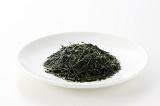Yame Dentou Hongyokuro
| Registration Number | 5 |
|---|---|
| Name of the GI | Yame Dentou Hongyokuro,Traditional Authentic YAME GYOKURO |
| Class | Processed Foodstuffs |
| Date of Protection | 2015/12/22 |
| Producing Area | Fukuoka Prefecture |
| Applicant - Name and Address | Traditional Authentic YAME GYOKURO Promotion Association 420-1, Motomura, Yame City, Fukuoka, 834-0063, JAPAN |
Traditional Authentic YAME GYOKURO is Japanese tea with a fragrant aroma. The hand-picked, fresh leaves are produced in Yame City and surrounding mountainous areas, and processed by traditional methods.
Among Japanese tea, "Gyokuro" is characterized by its characteristic green laver-like aroma called a "blanket scent" by covering the raw leaves while they are growing. In general, "Gyokuro tea" is covered with chemical fiber materials, but for fresh leaves of Traditional Authentic YAME GYOKURO, natural materials are used such as rice straw. Compared to chemical fiber materials, the temperature and humidity inside the coating are more suitable for growth of tea buds. Whereas the harvesting surface of regular Gyokuro is grown to be hemispherical, this Gyokuro tree is left to grow naturally so that sufficient nutrients are sent to each tea bud.
The scent is very rich, and it has been found that the content of fragrant ingredients with a "blanket scent" is high, more than 5 times as much as that of Sencha (a common Japanese tea without coating) of the same production area, and about twice as much as that of ordinary Gyokuro. Also, because it contains a large amount of theanine, which is a savory component, the content of astringent catechins is suppressed, so the taste of the percolate is thick, "mellow" and "rich".
In the semi-mountainous area dotted with leaf production tea gardens of Traditional Authentic YAME GYOKURO, the temperature difference in the morning and evening is large, morning fog often occurs, and from experience, it is considered to be a suitable place for tea production. Also, the greater temperature difference causes lower respiration of the plants at night. This results in accumulation of the more amino acids which are savory components. Crude tea processing techniques have continually been refined regardless of generation. In particular, competitions and workshops in "Hand rolling", the base of crude tea processing, are held every year by mainly young successors to pass down and enrich the technique.
Looking back over the history, it is said that the story of Yame tea began when the Zen priest who founded Reigan-ji Temple in Kasahara, Kuroki town, in Yame city in 1423, sowed tea seeds brought back from the Ming Dynasty, and taught how to make tea. After that, the production of Yame tea spread all over the mountain areas around 1820~1840. The tea seeds mainly in circulation at the origin of Yame tea were those of "Sencha", but it turned out that the area was suitable for Gyokuro tea production. About 1904, Gyokuro production began in earnest in Hoshino village in Yame city, and spread to the semi-mountainous areas thereafter.


